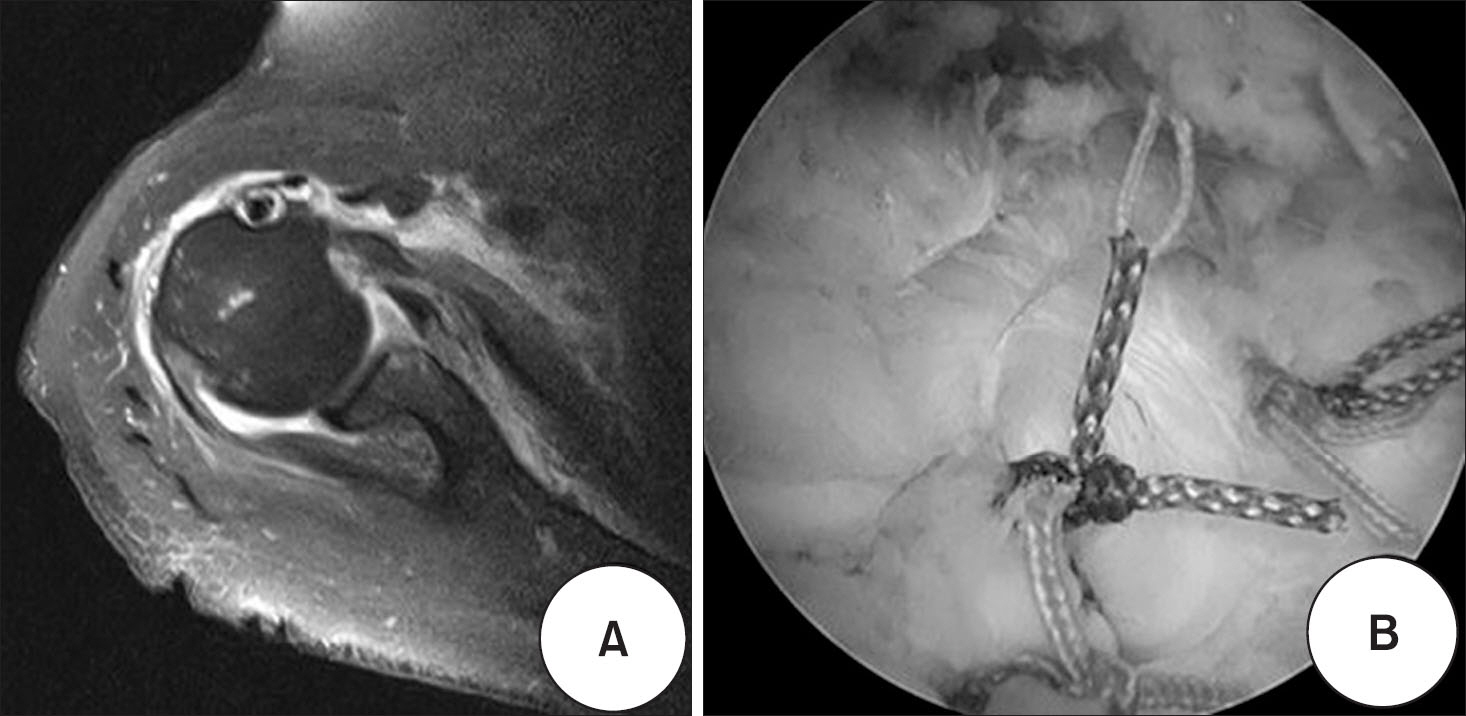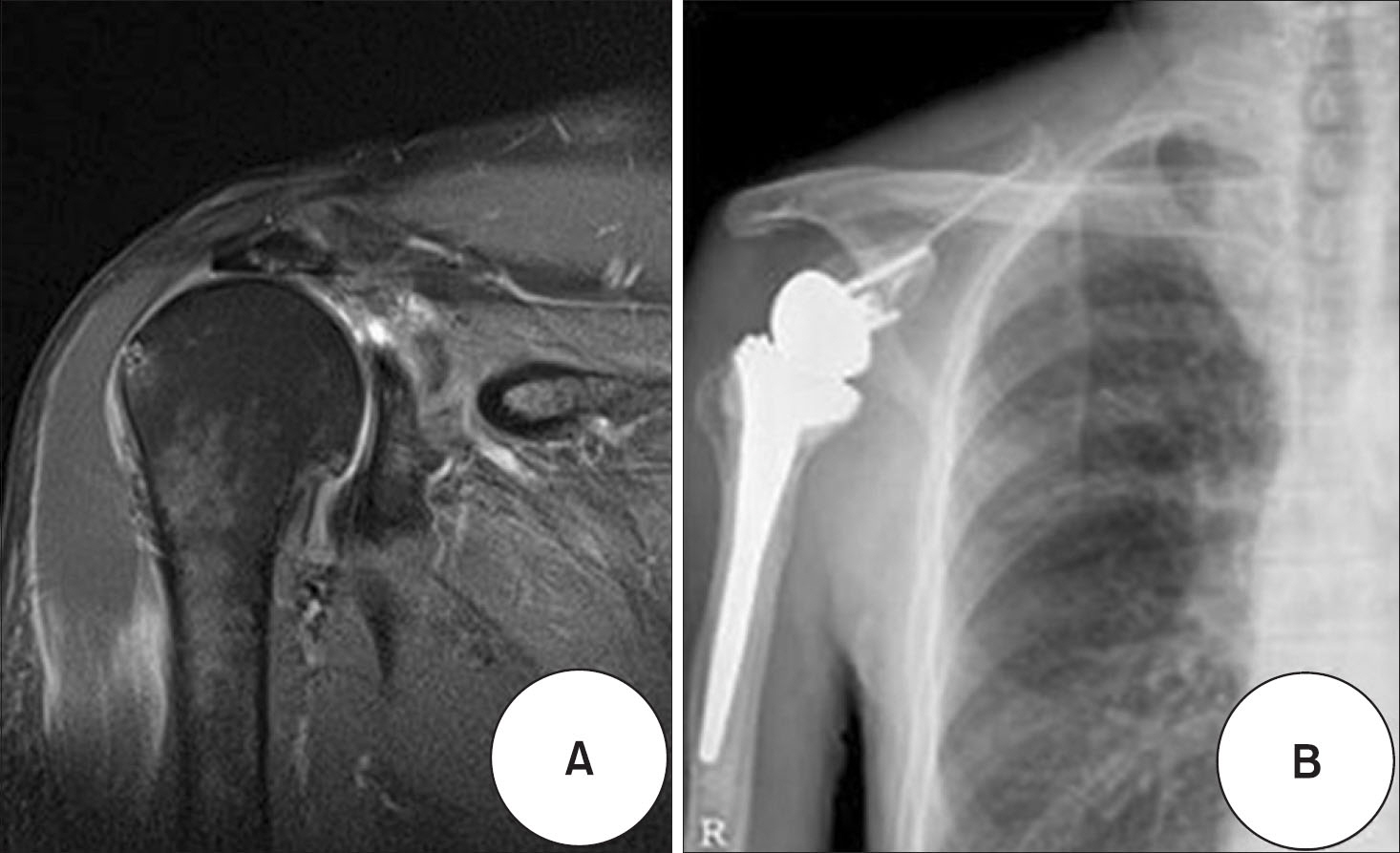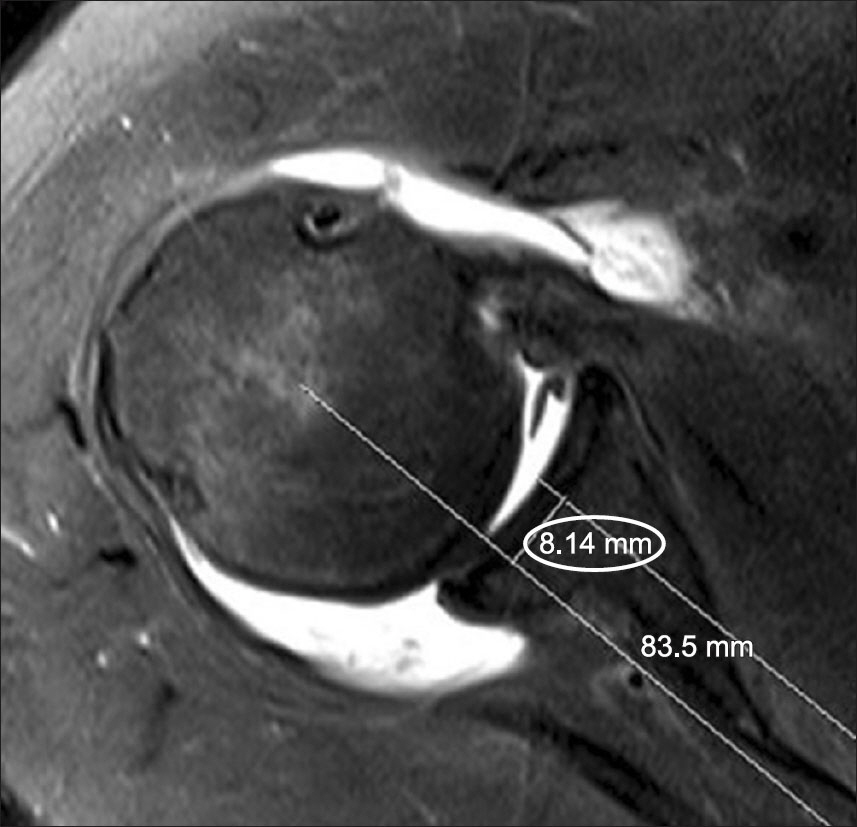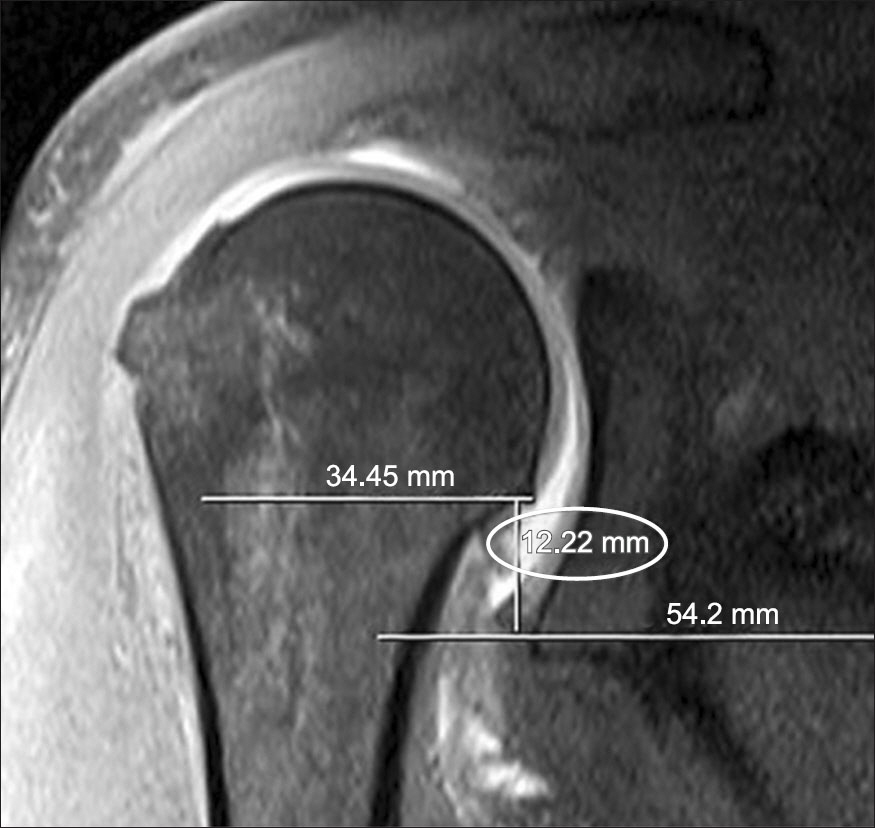J Korean Orthop Assoc.
2019 Oct;54(5):418-426. 10.4055/jkoa.2019.54.5.418.
Humeral Head Decentralization of Preoperative Magnetic Resonance Images and the Treatment of Shoulder Dislocations in Large to Massive Rotator Cuff Tears in Elderly over 65 Years Old
- Affiliations
-
- 1Department of Orthopedic Surgery, Daejeon Sun Hospital, Daejeon, Korea. mydangjang@naver.com
- KMID: 2461231
- DOI: http://doi.org/10.4055/jkoa.2019.54.5.418
Abstract
- PURPOSE
This study analyzed the features of humeral head decentralization in large to massive rotator cuff tears with a shoulder dislocation in the elderly. Moreover, shoulder instability and treatment were reviewed.
MATERIALS AND METHODS
From May 2005 to February 2017, Group A containing 45 cases (45 patients) over 65 years old accompanied by a large or massive rotator cuff tear with a shoulder dislocation and Group B containing 45 cases (45 patients) without a shoulder dislocation were enrolled. The mean ages in Groups A and B were 73.2 and 72.1 years old, and the mean follow-up periods were 30.7 and 31.3 months, respectively. Twenty-one cases (46.7%) in Group A underwent rotator cuff repair, and 8 cases (17.8%) underwent concomitant rotator cuff repair with Bankart repair. Sixteen cases (35.6%) underwent reverse total shoulder arthroplasty for cuff tear arthropathy. 45 cases (100%) in Group B underwent rotator cuff repair. The off-the center and head elevation were measured in the preoperative magnetic resonance imaging (MRI) of Groups A and B. The preoperative and postoperative visual analogue scale (VAS) score, American Shoulder and Elbow Surgeons (ASES) score, and University of California Los Angeles (UCLA) score in Groups A and B were compared.
RESULTS
In Groups A and B, the mean off-the centers were posterior 7.41 mm and posterior 2.02 mm (p=0.03), and the mean head elevations were superior 6.66 mm and superior 2.44 mm (p=0.02), respectively. The mean ASES scores of Groups A and B were 32.8 and 33.4 before surgery, and 77.1 (p=0.02) and 78.1 (p=0.02) after surgery (p=0.18), respectively. The mean UCLA scores of Groups A and B were 13.1 and 12.8 before surgery, and 28.9 (p=0.02) and 29.5 (p=0.01) after surgery (p=0.15), respectively.
CONCLUSION
Patients over 65 years old with a shoulder dislocation in large to massive rotator cuff tears had higher off-the center and head elevation on the preoperative MRI than those without a shoulder dislocation. This measurement can help predict preceding shoulder instability. Early rotator cuff repairs should be performed and other treatments, such as Bankart repair and reverse total shoulder arthroplasty, should also be considered.
MeSH Terms
Figure
Reference
-
References
1. Rowe CR. Acute and recurrent anterior dislocations of the shoulder. Orthop Clin North Am. 1980. 11:253–70.
Article2. McLaughlin HL. Trauma. Philadelphia: Saunders;1959. 233–96.3. Simank HG, Dauer G, Schneider S, Loew M. Incidence of rotator cuff tears in shoulder dislocations and results of therapy in older patients. Arch Orthop Trauma Surg. 2006. 126:235–40.
Article4. Gumina S, Postacchini F. Anterior dislocation of the shoulder in elderly patients. J Bone Joint Surg Br. 1997. 79:540–3.
Article5. Ribbans WJ, Mitchell R, Taylor GJ. Computerised arthroto-mography of primary anterior dislocation of the shoulder. J Bone Joint Surg Br. 1990. 72:181–5.
Article6. Pevny T, Hunter RE, Freeman JR. Primary traumatic anterior shoulder dislocation in patients 40 years of age and older. Ar-throscopy. 1998. 14:289–94.
Article7. Neviaser RJ, Neviaser TJ, Neviaser JS. Concurrent rupture of the rotator cuff and anterior dislocation of the shoulder in the older patient. J Bone Joint Surg Am. 1988. 70:1308–11.
Article8. Cofield RH. Rotator cuff disease of the shoulder. J Bone Joint Surg Am. 1985. 67:974–9.
Article9. Patte D. Classification of rotator cuff lesions. Clin Orthop Relat Res. 1990. 254:81–6.
Article10. Goutallier D, Postel JM, Bernageau J, Lavau L, Voisin MC. Fatty muscle degeneration in cuff ruptures. Pre- and postoperative evaluation by CT scan. Clin Orthop Relat Res. 1994. 304:78–83.
Article11. Visotsky JL, Basamania C, Seebauer L, Rockwood CA, Jensen KL. Cuff tear arthropathy: pathogenesis, classification, and algorithm for treatment. J Bone Joint Surg Am. 2004. 86 Suppl 2:35–40.12. McLaughlin HL, Cavallaro WU. Primary anterior dislocation of the shoulder. Am J Surg. 1950. 80:615–21; passim.
Article13. Stayner LR, Cummings J, Andersen J, Jobe CM. Shoulder dislocations in patients older than 40 years of age. Orthop Clin North Am. 2000. 31:231–9.
Article14. Neviaser RJ, Neviaser TJ. Recurrent instability of the shoulder after age 40. J Shoulder Elbow Surg. 1995. 4:416–8.
Article15. Hsu HC, Boardman ND 3rd, Luo ZP, An KN. Tendon-Defect and muscle-unloaded models for relating a rotator cuff tear to glenohumeral stability. J Orthop Res. 2000. 18:952–8.
Article16. Hsu HC, Luo ZP, Cofield RH, An KN. Influence of rotator cuff tearing on glenohumeral stability. J Shoulder Elbow Surg. 1997. 6:413–22.
Article17. Porcellini G, Paladini P, Campi F, Paganelli M. Shoulder instability and related rotator cuff tears: arthroscopic findings and treatment in patients aged 40 to 60 years. Arthroscopy. 2006. 22:270–6.
Article18. Boileau P, McClelland WB Jr, Rumian AP. Massive irreparable rotator cuff tears: how to rebalance the cuff-deficient shoulder. Hart RA, Della Valle CJ, editors. Rosemont (IL): American Academy of Orthopaedic Surgeons;2014. 71–83.
Article19. Ha JK, Yoo JD, Park SP, Shin SJ. Traumatic anterior shoulder dislocation in patients older than 60 years of age. J Korean Shoulder Elbow Soc. 2006. 9:42–9.
Article20. Sonnabend DH. Treatment of primary anterior shoulder dislocation in patients older than 40 years of age. Conservative versus operative. Clin Orthop Relat Res. 1994. 304:74–7.
Article21. Voigt C, Lill H. [Shoulder instability and rotator cuff tear]. Orthopade. 2009. 38:70–4.22. Itoi E, Tabata S. Rotator cuff tears in anterior dislocation of the shoulder. Int Orthop. 1992. 16:240–4.
Article23. Lee KW, Yang DH, Ahn JH, Kim HY, Choy WS, Ha KI. Recurrent shoulder dislocation with rotator cuff tears and bankart lesion. J Korean Orthop Soc Sports Med. 2004. 3:81–6.24. Ji JH, Park SE, Kim YY, Shin ES, Park BY, Jeong JJ. The analysis and treatment of rotator cuff tear after shoulder dislocation in middle-aged and elderly patients. J Korean Shoulder Elbow Soc. 2010. 13:20–6.
Article
- Full Text Links
- Actions
-
Cited
- CITED
-
- Close
- Share
- Similar articles
-
- Factors Influencing the Restoration of Acromiohumeral Distance of Immediate Postoperative Period in Patients Who Have Rotator Cuff Repair Surgery with Large-to-Massive Rotator Cuff Tears
- Current Concepts and Recent Trends in Arthroscopic Treatment of Large to Massive Rotator Cuff Tears: A Review
- Arthroscopic repair of large and massive rotator cuff tears—“sandwich augmentation” with the long head of the biceps tendon: a technical note
- Reverse Shoulder Arthroplasty for Humeral Head Fracture with Massive Rotator Cuff Tear in Elderly Patient
- Patch Augmentation for Massive Rotator Cuff Tears





